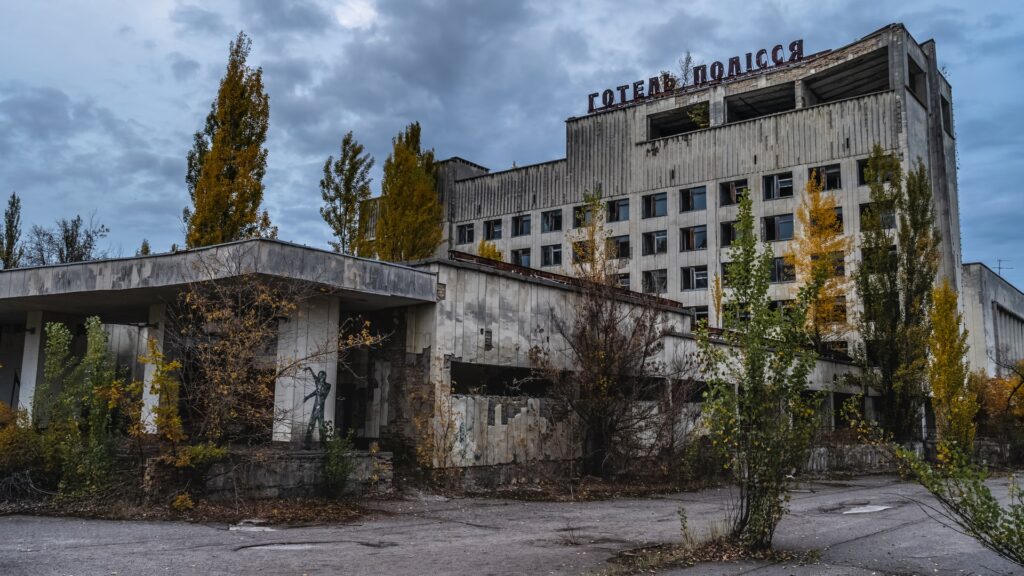
By Amber Bereznyckyj, History and Creative Writing student at the New College of the Humanities
Putin’s military strategy is based on four entry ‘axes’ – into Kharkiv, Kherson, and two from Belarus. The first entry was Chernobyl. It was taken over by Russian troops last Thursday. Many are now concerned about Russia’s plans to use the site of the world’s largest nuclear accident.
The Chernobyl disaster occurred in April 1986 due to a reactor fault, which resulted in multiple steam explosions in the plants’ cores. It instantly killed two workers and another twenty-eight from radiation poisoning. The explosions released 5% of the core’s radioactive material directly into the environment according to the World Nuclear Association. The town of Chernobyl had to be evacuated, and blame is still widely placed on the Soviet Union’s inadequate training. The nuclear waste from the Chernobyl disaster will take up to twenty thousand years to clean up. An NSC shelter was placed over the destroyed reactor 4 in 2016 to protect the decommission of the reactor from environmental influences such as water intrusion. Russia will not risk contamination elsewhere; ninety-three thousand fatal cancer cases have now been linked to the Chernobyl radiation and it is unlikely that nuclear exploitation of Chernobyl would be Putin’s long-term goal.
Pripyat reported on Friday gamma radiation levels were ten times higher than in recent weeks. The State Nuclear Agency explains that this is due to the disruption caused by military equipment, which releases radioactive dust into the air. Regardless of whether Putin wishes to use Chernobyl for nuclear reasons or not, nuclear experts are still trying to discern whether the unsettling of Chernobyl will have any long term consequences to civilians’ health.
The most practical reason for the take over of Chernobyl is that it lies almost ten miles from the Russian ally, Belarus, and only eighty miles from the now embattled capital, Kyiv. This includes the Chernobyl disaster exclusion zone of one thousand square miles. It, therefore, offers the most direct route to invade. The site sits to the west of the Pripyat River, which connects with the Dnieper River. This would allow Russian troops to cross the river in Belarus, rather than in Ukraine where the border would be on the defensive. Chernobyl is strategically important for the Western Russian flank to encircle the capital. It would also mean that Russia could be in control of the Chernobyl substation, which is crucial to electricity supplies in both, Western Russia and Belarus.
The most prevalent reason for the take-over is its symbolism. It does have logistical advantages as it holds supplies for Western Russia and Belarus. However, the reason for it being the first axe is that it was a warning to NATO of what is to come if they intervene. The Taliban are known to use the same approach — they bomb places of international cultural memory rather than someplace useful to the locals, such as the Buddhas of Bamiyan. This strategy is so powerful because it adds notoriety to the aggressor and a sense of irreversible damage. Therefore, NATO involvement seems more hopeless, it essentially lowers international morale and prevents foreign aid for the country under fire. Chernobyl to the Ukrainians, is still a tragedy, but also ‘a useless piece of real estate,’ whereas for the world it is the most famous location in Ukraine. It has value to the western allies, who had previously promised to back Ukraine in 1994 with the Budapest Memorandum. The agreement ensured military support from NATO if Ukraine were to be invaded, on the condition that Ukraine gives up their nuclear weapons.
Chernobyl was Putin’s messaging card for war. Now, the EU has organised to send weapons over to Ukraine, convincing Germany, for the first time, to dedicate 2% of their GDP to defence. The Ukrainians took control of Kharkiv after Russian troops attacked today and the Ukrainian President has organised talks at the Belarusian border.